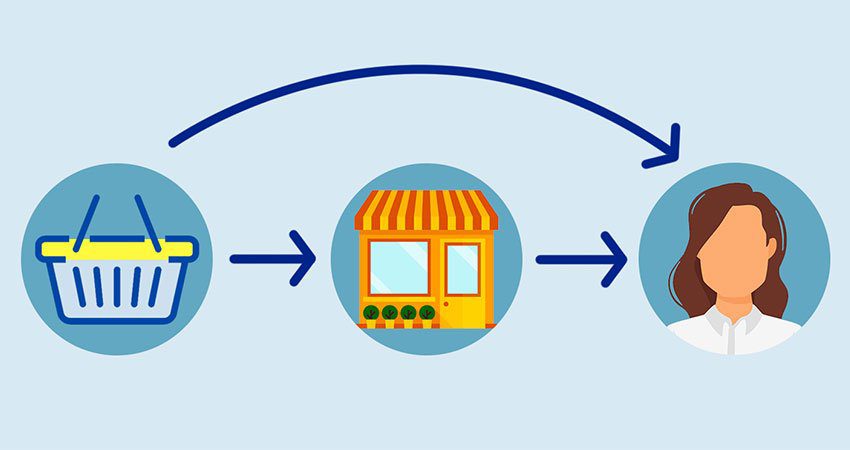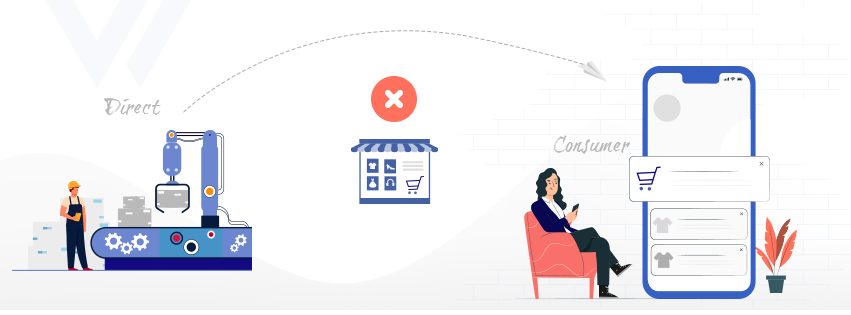D2C direct to consumer has gained significant traction in recent years and is continuously being driven by evolving consumer demands and technological advancements in digital commerce. This approach enables the brands to curate unique experiences for each of their consumers and ensures they offer a consistent experience.
The global direct to consumer commerce market size is expected to grow at a Compound Annual Growth Rate (CAGR) of 17.30% from 2025 to 2033, reaching $2.75 trillion by 2033.
This growth can be attributed to the rise of online shopping and social media, which helps businesses reach their target audience where a stronger relationship is created. As technology advances, this ecommerce business model will play a greater role in shaping the future of ecommerce shopping experiences.
Key Takeaways
- The d2c ecommerce model facilitates direct selling to consumers bypassing the intermediaries to provide greater control over branding, pricing, marketing, and customer experience.
- Direct to consumer e commerce adoption has accelerated with the rise of mobile commerce, and AI-driven personalization. This has facilitated brands to reach consumers directly through their digital touchpoints.
- The absence of intermediaries in the d2c direct-to-consumer e-commerce business model has led to retaining more revenue per sale, enabled personalized marketing, better customer engagement, and improved loyalty.
- D2C ecommerce also comes with its challenges like high customer acquisition costs, fulfillment complexities, and the need to build trust.
- Traditional brands are making the shift to D2C, while ecommerce giants like Amazon and Walmart are introducing labeled storefronts and fulfillment services to attract D2C brands.
What is Direct to Consumer E commerce?

Direct to consumer e commerce is a retail model that sells directly to consumers, eliminating the need for middlemen like third-party distributors, wholesalers, or retailers. In this business model, the entire sales process beginning from marketing to distribution is handled and managed by the respective brands.
For direct to consumer e commerce, brands use various digital touchpoints like social media platforms, brand-owned websites, and mobile apps. Not only do these brands have control over the process but over the pricing and customer experience as well, which forms the most crucial aspect of the process.
Understanding the Direct to Consumer (D2C) Business Model
Direct-to-consumer e-commerce goes beyond the definition, this type of business model has its unique features that differentiate it from the other business models. These key features form the core aspect of d2c ecommerce.
- Direct access to consumers helps in getting unfiltered feedback that can be used to strategize marketing for enhancing customer engagement.
- The absence of the intermediaries allows for more revenue to be retained per sale so the profits are higher.
- The absence also facilitates faster delivery as the consignment does not need to be transferred to many parties before reaching the final consumer.
- Brand consistency can be maintained throughout the process to ensure a consistent shopping experience without getting tainted by the interference of the intermediaries.
Read More: 10 Types of Online Shoppers & How Ecommerce Stores Can Convert Them Fast!
Evolution of Direct-to-Consumer E-commerce model
1. Manufacturer-Driven Sales in the Early Years (Pre-2000s)
- Manufacturers used to distribute their goods through wholesalers and retailers.
- There was little direct communication between brands and customers.
2. E-commerce’s Ascent (2000–2010): The Transition Starts
- Online shopping became commonplace after the rise of ecommerce giants like Amazon and eBay.
- Majority of the brands relied on marketplaces while others launched their websites.
- Online transactions became safer and were increasingly used.
3. The D2C Boom: Brands Take Charge (2010–2020)
- Without depending on marketplaces, brands were able to create their online stores with ecommerce website builders.
- D2C growth was driven by digital marketing, specifically influencer and social media marketing.
- By selling directly to customers, well-known D2C companies upended established markets.
- Personalized shopping experiences and subscription models became more and more popular.
4. The Acceleration of the Pandemic (2020–2023): Quick Digital Uptake
- The D2C direct to consumer trend was accelerated by COVID-19, driving brands to go digital.
- A growing number of brands integrated their websites, social media accounts, and physical stores through omnichannel strategies.
- Better data collection and more personalized marketing were made possible by direct consumer relationships.
- Issues with the supply chain compelled brands to reconsider their fulfillment tactics.
5. The Modern D2C Era (2024 & Beyond): Sustainable and AI-Driven Growth
- Customer experiences are changing as a result of automation and AI.
- Ethical sourcing and sustainability are increasingly important selling points.
- Instead of concentrating only on customer acquisition, D2C brands are focusing on community development and customer retention.
- The speed and flexibility of websites are being enhanced by the growth of progressive web apps (PWAs) and headless commerce.
Why is D2C Ecommerce a Consumer-Centric Approach?
- First-party data can be collected unfiltered to offer personalized recommendations, promotions, and experiences.
- Direct communication helps establish solid brand consistency which builds trust, loyalty, and long-term engagement.
- Brands can have complete control over all aspects of the sales process, including marketing, in the growing d2c ecommerce market.
- Feedback can be quickly collected and product tuning can be executed quickly.
- Without intermediaries, exclusive prices can be offered with discounts and unique product bundles.
- Online and offline experiences can be integrated to make shopping a convenient experience.
The direct to consumer e commerce business model has seen tremendous growth over the years, thanks to brands that have taken this bold initiative to enter the industry. It is this decision that has aggregated such a huge market. Join them and contribute to this growing trend of ecommerce sales.
Start with a demo with Webnexs experts to make the first move in the market – A robust platform that can stand out in the competitive market.
The Growth of Ecommerce D2C Sales
Market Trends & Statistics on D2C Sales Growth (2024-2025)
The d2c direct-to-consumer e commerce sales in the United States have been positive with an upward trajectory.
The top players in this industry generated approximately $135 billion in sales in 2023.
It is projected to increase to $187 billion by 2025. This demonstrates the shift that is happening towards a personalized shopping experience.
Additionally, mobile commerce is on the rise. With mobile-first technology, the shopping experience has drastically improved.
Last year (2024), mobile ecommerce alone generated $2.7 trillion in revenue. This accounted for 57% of the total ecommerce sales across all touchpoints.
This trend signifies the shopping experiences delivered by mobile-optimized d2c ecommerce brands.
How D2C Leverages Social Commerce, Subscriptions, & Influencer Marketing?
– Social Commerce
Social media is gaining significance as direct-to-consumer e-commerce brands are increasingly utilizing these platforms to enable direct purchases.
This merger would facilitate the shopping experience to a greater level.
For this purpose, platforms like Facebook, Instagram, and others have designed their platforms to have shopping functionalities.
Since social platforms are highly engaging, this would further drive the growth of these D2C brands and the platforms as well.
– Subscriptions
Subscription-based purchases reflect ongoing relationships between the consumers and the direct to consumer e commerce brands.
Purchasing regularly helps in building customer loyalty and, to a certain extent, provides predictable revenue streams.
This can itself become a source of new customers when satisfied customers become a word-of-mouth marketing tool.
– Influencer Marketing
Influencer collaboration will yield good results for brands seeking to scale up their business.
The authentic endorsements provided by influencers showcasing/demonstrating the product drive the purchase decisions of potential customers.
Niche areas can be served well using this strategy.
Factors to Consider When Going for D2C Ecommerce
1. Business Factors
- Target Audience
In the growing d2c ecommerce market, the target audience’s demographics, psychographics, and behavior must be identified, and buyer personas must be created to optimize marketing and sales efforts.
71% of companies consider understanding their customers’ needs and preferences as crucial for their business success.
- Unique Selling Proposition (USP)
A compelling selling point must be developed after conducting a gap analysis of all the offerings in the industry to gain a larger customer base.
Companies that have a strong USP are 2.5 times more likely to experience revenue growth.
- Product Offerings
A product roadmap must be created after conducting market research to ensure it aligns with the needs and wants of the target audience in the direct to consumer commerce model.
75% of online shoppers prefer buying from brands that offer personalized products.
- Pricing Strategy
Conducting competitor pricing analysis will help in developing the price structure that is most appropriate for your target audience.
60% of consumers consider price as the most important factor when making a purchasing decision.
2. Marketing and Sales Factors
- Brand Identity
A brand positioning statement, visual elements, brand voice, and tone must be developed in a way that resonates well with the target audience in direct-to-consumer e-commerce.
Consistent branding can increase revenue by up to 33%.
- Content Marketing
High-quality, engaging content must be developed as part of the content strategy and distributed effectively to gather a larger customer base in direct to consumer ecommerce.
72% of marketers consider content marketing as an effective SEO tactic.
- Influencer Marketing
Use influencers to boost the marketing effort, devise a strategy, monitor and measure the performance of influencer marketing, and revise the strategies to achieve improved results in the future.
Influencer marketing can generate up to $6.50 in revenue for every dollar spent.
- Email Marketing
Collect a list of emails, create content, and engage with your customers in the d2c ecommerce model to maintain a rapport, and they will become a word-of-mouth marketing tool.
Email marketing can generate up to $44 in revenue for every dollar spent.
3. Operational Factors
- Ecommerce Platform
Ecommerce platform options must be evaluated and integrated with existing systems to support business growth.
- 64% of online shoppers prefer shopping on websites with user-friendly interfaces.
- Payment and Shipping Options
In direct to consumer e commerce, multiple payment options must be offered, integrated with shipping providers, and information on shipping and payment must be displayed.
28% of online shoppers abandon their carts due to shipping costs.
- Inventory Management
Set up an inventory management system to track, alert, and optimize inventory storage for order fulfillment.
Inventory management can reduce costs by up to 15%.
- Customer Service
Serve your customers in d2c ecommerce by providing multichannel support, monitoring, and measuring the performance of your executives to ensure customer satisfaction.
73% of customers consider customer service as an important factor when making a purchasing decision.
4. Technical Factors
- Website Design and Development
Your d2c ecommerce website must be user-friendly and intuitive for seamless navigation. Website performance must be monitored and optimized accordingly.
38% of online shoppers will stop engaging with a website if it’s not visually appealing.
- Mobile Optimization
Your d2c ecommerce application must be optimized for mobile as well, as ecommerce shopping on mobile is a growing trend and must be catered to carefully.
52% of online shoppers prefer shopping on mobile devices.
- Security and Compliance
Customer data, such as personal and transaction details, must be secured with security measures to meet compliance guidelines for smoother operations.
61% of online shoppers consider security as the most important factor when making a purchasing decision.
- Analytics and Performance Tracking
Analytics tools in the d2c ecommerce market are crucial for tracking performance, customer behavior, and sales to use the data for making business decisions.
63% of marketers consider analytics as crucial for their business success.
5. Financial Factors
- Budget Allocation
Processes in the direct to consumer e commerce business model, like marketing, website development, and other cost-consuming activities, require budget allocation based on business objectives.
55% of marketers allocate up to 30% of their budget to digital marketing.
- Revenue Projections
Based on sales performance and business strategies, realistic revenue projections must be made in the direct-to-consumer e-commerce model to avoid unnecessary confusion.
Reducing costs by 10% can increase profitability by up to 15%.
- Cost Control
Cost-control measures must be implemented to optimize operational efficiency to maintain profitability.
Ecommerce sales are expected to reach $7.4 trillion in 2025.
- Scalability
Expansion of the d2c ecommerce business in the future requires planning business infrastructure and operations in the present for a smooth transition.
62% of businesses consider scalability as crucial for their growth.
There is immense potential for D2C brand entrants given the changing consumer behavior. These numbers represent growth potential.
Read More: TikTok Shop Marketplace Model: What it is and How it Impacts Ecommerce Markets
Benefits of Direct to Consumer E commerce
1. Higher Profit Margins
D2C brands can retain complete control over the financial aspects by eliminating the intermediaries like distributors, wholesalers, and retailers.
70% of D2C brands report higher profit margins compared to traditional retail models.
2. Better Customer Relationships
Strong customer management in the d2c ecommerce space can be built, as there will be direct communication between the customers and the brand.
D2C brands report a 20-30% increase in customer loyalty due to direct communication.
3. Greater Brand Control
The d2c ecommerce brands can completely operate on branding and other aspects in the process without relying on third parties.
85% of D2C brands report having more control over their brand image and messaging.
4. Data-Driven Insights
The direct to consumer e commerce industry helps in getting firsthand, unfiltered customer information that can be used to optimize the business strategy for effective results.
80% of D2C brands report using customer data to inform product development and marketing strategies.
5. Faster Time-to-Market
As there are fewer parties involved in the process, brands can reach the market sooner in terms of launching and testing products.
70% of D2C brands report being able to respond faster to changes in customer demand.
6. Personalized Customer Experience
Direct communication in the d2c ecommerce space helps in designing promotions, suggestions, and loyalty programs to serve customers well.
D2C brands report a 15-20% increase in sales due to personalized marketing and promotions.
All of these benefits give d2c ecommerce brands a higher advantage, often ranging from 10% to 30% more than traditional retail or marketplace models.
Challenges of Running a Direct to Consumer Commerce Business
1. Customer Acquisition Costs (CAC) Are High
Heavy investment in direct to consumer e commerce marketing is required without retail partners; additionally, it is also time-consuming.
The average cost of acquiring a customer through paid advertising channels is around $55-$65.
2. Logistics and Fulfillment Complexities
Complex operations in direct-to-consumer e-commerce, like managing warehouses, shipping, and returns, could be expensive and operationally challenging.
The global e-commerce logistics market is expected to reach $1.4 trillion by 2025, growing at a CAGR of 17.3%.
3. Limited Brand Trust in the Beginning
New entrants into the d2c ecommerce segment must establish credibility and trust; without supporting intermediaries, this would be challenging.
81% of consumers trust recommendations from family and friends over those from companies.
4. Intense Competition
Ecommerce giants like Amazon and Alibaba operate on a large scale with millions of monthly website visits, competing with them in pricing and faster delivery can be difficult.
Amazon accounts for 38% of the US e-commerce market share, making it a significant competitor for d2c ecommerce businesses.
Despite challenges, D2C businesses enjoy higher profit margins by eliminating intermediaries. With agility in innovation and direct consumer interactions, d2c ecommerce brands can outperform traditional retail models in the long run.
To realize the benefits of this industry with immense potential, you need to penetrate the market with a platform positioned to attract a mass audience.
Webnexs specializes in building ecommerce platforms. Request a free demo from our team to guide you in the process.
How is D2C Ecommerce Transforming Traditional Retail?
Why Are Traditional Brands Shifting to D2C?
Top brands like Apple, Nike have shifted to the d2c ecommerce model to obtain the benefits of increased profit margins, unfiltered first-hand customer data, and others.
To cite an example there is Nike that withdrew its listing on Amazon to focus on its website sales and the other hand Apple further strengthened its ecosystem through its own website sales and retail stores.
75% of traditional retailers plan to launch a D2C channel within the next two years.
How Big Retailers & Marketplaces Are Adapting?
The counter actions for this trend from ecommerce giants like Amazon and Walmart are evolving.
To attract d2c ecommerce brands they are expanding private-label brands, enabling exclusive storefronts for sellers, and enhancing fulfillment services like Amazon Buy with Prime and Walmart Fulfillment Services.
Walmart has acquired D2C brands to strengthen its digital presence.
Amazon’s private-label business generates an estimated $20 billion in annual sales.
AI-Driven Future of Retail & Direct Selling
AI has swept into every industry, enhancing direct-to-consumer e-commerce by personalizing shopping experiences, automating customer interactions, and optimizing supply chains. Product recommendations are powered by machine learning, while chatbots handle real-time customer support.
61% of retailers plan to use AI to personalize customer experiences.
New brands in direct to consumer commerce benefit from this transformation by maximizing revenue while leveraging AI-driven data to enhance customer experiences and retention. Additionally, evolving marketplace support allows D2C brands to scale efficiently without high operational costs.
Why is Direct-to-Consumer D2C the Next Shift in Ecommerce?
1. Changing Consumer Behavior
Customers expect personalized shopping experiences and this has become a greater demand as technological advancements for the same set in.
In direct to consumer commerce, access to first-party customer data enables AI-driven product recommendations, targeted email campaigns, and dynamic pricing.
Additionally, exclusive deals and product selections can be offered as well.
The data is also used to segment the target audience, make predictive analysis, and customize interactions.
This helps achieve higher conversion rates and customer loyalty.
2. Rise of Social & Mobile Commerce
Social media platforms integrate shopping functionalities like shoppable posts and others to directly convert users into customers while engaging with the content.
In direct-to-consumer e-commerce, AI personalizes the shopping feed to make product listings more relevant to the target audience.
Additionally, mobile commerce is dominating the online shopping segment by reducing friction, shortening the sales funnel, and enhancing engagement.
3. Better Profitability & Brand Control
D2C ecommerce brands can retain higher profits, set competitive prices, offer exclusive discounts, and manage promotions independently.
Furthermore, there is complete control over all the operations.
This helps in curating a unique shopping experience for the customers.
As a result, a consistent brand identity can be created. This makes it an alternative to traditional marketplaces.
Examples of Successful Ecommerce Direct to Consumer Brands
1. Warby Parker (Eyewear)
Founded: 2010
Industry: Eyewear
Specialization: Stylish, high-quality, and affordable glasses.
Why They Chose D2C
- The players in the direct to consumer ecommerce industry faced less competition with only a few major players controlling pricing.
- Traditional marketplaces sold glasses at expensive rates.
Success Factors
- They allowed customers to try on up to 5 glasses at home for free for a risk-free shopping experience.
- They offered free services like shipping, returns, and customization of prescription lenses.
- In the later stages of d2c ecommerce, they introduced physical stores to enhance the convenience of shopping.
- Currently, it is valued at over $2 billion with over 200 retail locations.
2. Glossier
Founded: 2014
Industry: Beauty
Specialization: Skincare, makeup, body care, fragrance, and merchandise.
Why They Chose D2C
- To build a direct relationship with customers through social media.
- Testing and launching their products in the direct to consumer e commerce industry could be quickly done based on customer demand.
Success Factors
- By allowing customers to participate in product development they built a loyal customer base.
- Advertisements were created from real customer testimonials and user-generated content.
- They created Instagram-friendly aesthetic product appeal as part of their differentiation strategy.
- Currently they are generating more than $100 million in annual revenue in the d2c ecommerce space and are valued at $1.8 billion.
3. Casper
Founded: 2014
Industry: Mattress
Specialization: Memory foam and hybrid mattresses, sleep technology
Why They Chose D2C
- Traditional methods of buying were expensive and required aggressive sales tactics.
- Needed to make mattresses affordable.
Success Factors
- They positioned sleep as an essential choice and not just a product in the direct to consumer commerce industry.
- A 100-night trial was offered and a return option was available if customers were unsatisfied.
- Logistics were seamless due to the compressing of mattresses for shipping in a box.
- Generated over $100 million in sales within two years.
One common quality of all these three examples represents uniqueness in their strategy, by taking a different approach, a larger mass of the target audience can be covered, and if that works, the growth prospects are great.
Come up with a differentiation strategy and we will build the platform, together we can make your d2c ecommerce brand thrive in the market.
Wrapping up
The market is filled with opportunities given the advantages that d2c ecommerce business model poses, this can be leveraged by brands to strip down unnecessary operations and shedding profits to intermediaries. Revenue retention rates are high, all of these factors eventually lead to profits and this is a lucrative avenue for retaining the same.
Furthermore, the onset of AI and ML has changed the ecommerce business dynamics, making the business even more profitable. The way brands interact with consumers and the way consumers make their purchase decisions is facilitated by advancements in technology. While the short-term benefits are appealing, the long-term growth with the right strategy for positioning will result in a thriving D2C ecommerce leader.
And you could be that leader if you make the move by starting with building a platform with Webnexs.




